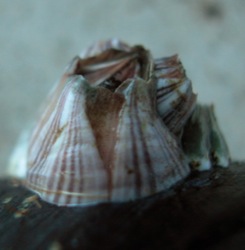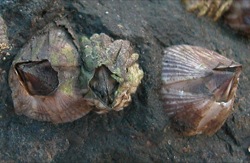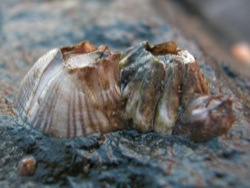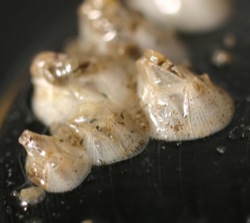Balanus amphitrite Darwin, 1854
STRIPED BARNACLE
- Kingdom: Animalia
- Phylum: Arthropoda
- Subphylum: Crustacea
- Class: Maxillopoda
- Subclass: Thecostraca
- Infraclass: Cirripedia
- Superorder: Thoracica
- Order: Sessilia
- Suborder: Balanomorpha
- Superfamily: Balanoidea
- Family: Balanidae
Balanus amphitrite is a small, roughly conical barnacle that reaches a maximum diameter of about 20 mm. It has white walls with vertical bands of purple or red-brown stripes. Both the stripes and the white spaces between them are typically wider at the bottom and narrow toward the top. The walls are often smooth, but sometimes have shallow vertical ridges. Any red- or purple-striped barnacle found in San Francisco Bay is likely to be this species.
Balanus amphitrite is the type of barnacle called an "acorn" rather than a "gooseneck" barnacle. Acorn barnacles have an outer wall made of rigid plates, and attach directly to rock, wood or other substrates without an intervening, fleshy stalk. The animal lives inside these walls and feeds by extending a set of appendages, which it uses as a kind of net to capture food particles, out through an opening at the top. The opening is closed by a lid that opens by flexing out to the sides. This lid, called the operculum, consists of two symmetrical halves, each made of two roughly triangular, rigid plates that interlock along one edge and are attached to an inner membrane. The larger plate at the barnacle's "head" end is called the scutum (plural scuta), and the smaller plate at the hind end is the tergum (plural terga).
Features of the scutum and tergum are often important in distinguishing among similar species of barnacles. To see these features one needs to break open a barnacle, remove and separate the terga and scuta, and clean them of tissue so their outlines and inner surfaces can be examined. Careful scraping is sometimes sufficient for this, but a short soaking in bleach is often helpful. In Balanus amphitrite, the outer surface of the scutum is not marked by either lines or rows of pits running from the base up toward the apex, such as are found in some other Pacific Coast species; a spur protrudes from the base of the tergum that is about 1/3 the width of the base; and on the inner surface of the tergum there is a well-defined set ridges on the outer corner (opposite the edge that interlocks and articulates with the scutum) where a muscle attaches.
Balanus amphitrite is a common fouling barnacle in harbors, and there are many records of this species on the hulls of ships around the world. It occurs on rocks, pilings and seawalls; on the shells of living oysters, mussels and crabs; and in warmer waters, on mangrove roots. Although Balanus amphitrite tolerates water temperatures down to 12°C, it requires temperatures of at least 15-18°C and salinities of at least 10-15 ppt to breed. In Britain and the Netherlands, it lives in waters heated by the outflow from power plants (Vaas 1978).
Similar Species
Balanus trigonus is a primarily subtidal barnacle that ranges from Monterey Bay to Peru, and has been introduced to some other parts of the world. It grows to a maximum diameter of about 15 mm, but is usually smaller. It has white walls with reddish mottling that can resemble stripes. Unlike Balanus amphitrite, however, its walls have strong vertical ridges, and the outer surface of the scutum has one or more rows of pits running from the base toward the apex.
Megabalanus californicus is a primarily subtidal barnacle that ranges from Humboldt Bay to Mexico, but is uncommon north of Monterey Bay. It grows much larger than Balanus amphitrite (to 60 mm diameter). It has white walls that often have vertical red stripes, and are sometimes vertically ridged. The muscle attachment site on the outer corner of the inner surface of the tergum is marked by fainter and less distinct ridges than in Balanus amphitrite.
Paraconcavus pacificus is a primarily subtidal barnacle that ranges from Monterey Bay to Baja California. It usually lives attached to other organisms, such as sand dollars, on sandy bottoms. It grows to a diameter of 35 mm, and has smooth white walls with reddish stripes. There are fine lines running from the base up toward the apex on the outer surface of the scutum, which distinguishes this species from Balanus amphitrite.
Native Range
Probably from the Indian Ocean to the southwestern Pacific, where it is considered to be native based on the presence of Pleistocene fossils; however, it has been reported as an exotic species in New Zealand and Australia (Foster 1978). Plio-Pleistocene fossils have also been reported from Argentina, though it is not considered native there (Oresanz et al. 2002, p. 121).
Introduction and Distribution on the Pacific Coast [with dates of first record]
- California: San Francisco Bay [collected on the hull of the submarine Narwhal at Mare Island Naval Shipyard in 1929, and on non-transient substrates in the bay in 1938-39], Venice [collected in 1957], Marina del Rey [collected in 2000], Los Angeles/Long Beach Harbor [collected in 1914], Alamitos Bay [collected in 1955], Anaheim Bay [reported in 1975], Huntington Beach [collected in 1956], Newport Bay [collected in 1956], La Jolla [collected in 1919], Mission Bay [collected in 1974], San Diego Bay [collected in 1927], Salton Sea [collected in 1944]
- Baja California: Ensenada [collected in 2000], Laguna San Ignacio [reported in 1994], Bahia Magdalena, Gulf of California [1946]
In San Francisco, Bay Balanus amphitrite has been reported primarily from shallow lagoon or backwater areas which may have generally warmer waters. These include Aquatic Park and Bay View Park in San Francisco, Coyote Point, and the Palo Alto Yacht Harbor (collected in the 1950s; the Yacht Harbor no longer exists) on the west side of the Bay; Aquatic Park in Berkeley, Lake Merritt (at 21-22°C) and the Oakland Estuary (at 17-19°C) on the east side of the Bay; and at Alviso (in a pond at 22°C and 52 ppt salinity) at the south end of the Bay.
Balanus amphitrite was first collected on the Pacific Coast in Los Angeles Harbor in 1914. It most likely arrived attached to the hull of a ship, as it is one of the most frequently reported species in hull fouling. For example, in the 1920s it was found on over 20% of the ship hulls examined (WHOI 1952), and the first record for this species in San Francisco Bay was also from a vessel hull. Its spread to San Diego Bay by 1927 and to San Francisco Bay by 1938-39 was most likely via ships or boats from Los Angeles Harbor, though these introductions could also have occurred independently on the hulls of ships arriving from overseas. It is possible but not very likely that the initial introductions to these port sites resulted from larvae transported in ballast water, given the relatively early records at these sites. Spread to bays without cargo parts was probably through hull fouling or through larvae carried in currents along the coast. Introduction to the inland Salton Sea in the 1940s probably resulted from barnacles attached to navy planes, boats, buoys or other equipment transferred from San Diego Bay for training purposes (Carlton 1979).
Additional Global Distribution [with dates of first record]
Hawaii [collected in 1902]; Pacific Coast of Panama [reported in 1980]; North Carolina [collected in 1883] to Florida [1940s?] with occasional records north to Massachusetts; Bermuda [collected in 1962], Gulf of Mexico [1954], Dominican Republic [collected in 1965], Puerto Rico [collected in 2002], Jamaica [reported in 1991], Trinidad; Brazil [collected at Rio de Janeiro in 1968] and Argentina [observed in the 1960s]; southern England [collected in 1937], southern Wales and the Netherlands [collected in 1962]
Balanus amphitrite has been introduced to tropical to warm-temperate waters in many parts of the world, primarily as hull fouling although possibly also transported with oyster shipments or in ballast water. A early as 1854, Darwin noted that Balanus amphitrite and a few other barnacles "which seem to range over nearly the whole world (excepting the colder seas)" could have been transported to parts of their range as fouling on ships.
Other names that have been used in the scientific literature
Balanus amphitrite herzi, Balanus amphitrite franciscanus, Balanus amphitrite saltonensis
Literature Sources and Additional Information
Carlton, J.T. 1979. History, Biogeography, and Ecology of the Introduced Marine and Estuarine Invertebrates of the Pacific Coast of North America. Ph.D. thesis, University of California, Davis, CA (pp. 585- 591).
Cohen, A.N. and J.T. Carlton. 1995. Nonindigenous Aquatic Species in a United States Estuary: A Case Study of the Biological Invasions of the San Francisco Bay and Delta. U.S. Fish and Wildlife Service, Washington, DC (p. 79).
Darwin, C. 1854. A Monograph on the Sub-Class Cirripedia, with Figures of all the Species: the Balanidae, (or Sessile Cirripedes); the Verrucidae, Etc., Etc., Etc. The Ray Society, London.
Foster, B.A. 1978. The marine fauna of New Zealand: Barnacles (Cirripedia, Thotacica). Memoirs of the New Zealand Oceanographic Institute 69: 1-160.
Morris, R.H., D.P. Abbott and E.C. Haderlie. 1980. Intertidal Invertebrates of California. Stanford University Press, Stanford, CA (pp. 523-524).
Orensanz, J.M., Schwindt, E., Pastorino, G., Bortulas, A., Casas, G., Darrigan, G., Elías, R., Gappa, J.J.L., Obenat, S., Pascual, M., Penchaszadeh, P., Piriz, M.L., Scabarino, F., Spivak, E.D. and E.A. Vallarino. 2002. No longer the pristine confines of the world ocean: a survey of exotic marine species in the southwestern Atlantic. Biological Invasions 4: 115-143.
WHOI. 1952. Marine Fouling and its Prevention. Woods Hole Oceanographic Institution Contribution No. 580, U. S. Naval Institute, Annapolis MD (pp. 38-39, 91).
Vaas, K.F. 1978. Immigrants among the animals of the delta-area of the SW. Netherlands. Hydrological Bulletin 9: 114-119.
Zullo, V.A., Beach, D.B. and J.T. Carlton. 1972. New barnacle records (Cirripedia, Thoracica). Proceedings of the California Academy of Sciences 39(6) 65-74.
Websites
Bishop Museum and University of Hawaii - Guidebook of Introduced Marine
Species of Hawaii
http://www2.bishopmuseum.org/HBS/invertguide/species/balanus_amphitrite.htm
Elkhorn Slough National Estuarine Research Reserve - Least Wanted Aquatic
Invaders
http://www.elkhornslough.org/research/aquaticinvaders/aquatic6.htm

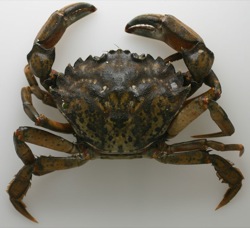 Carcinus maenas
Carcinus maenas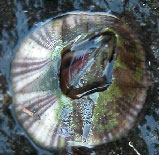 Balanus amphitrite
Balanus amphitrite